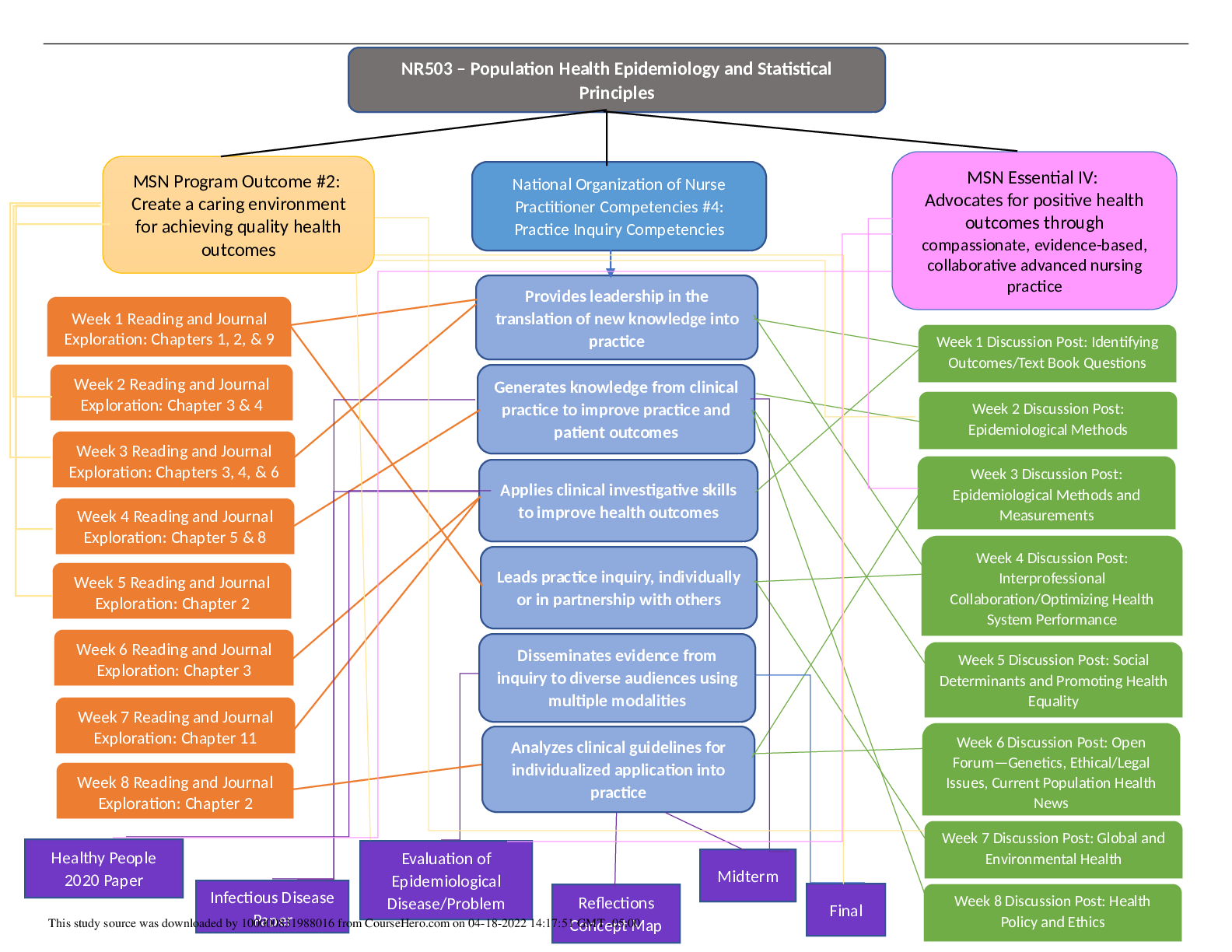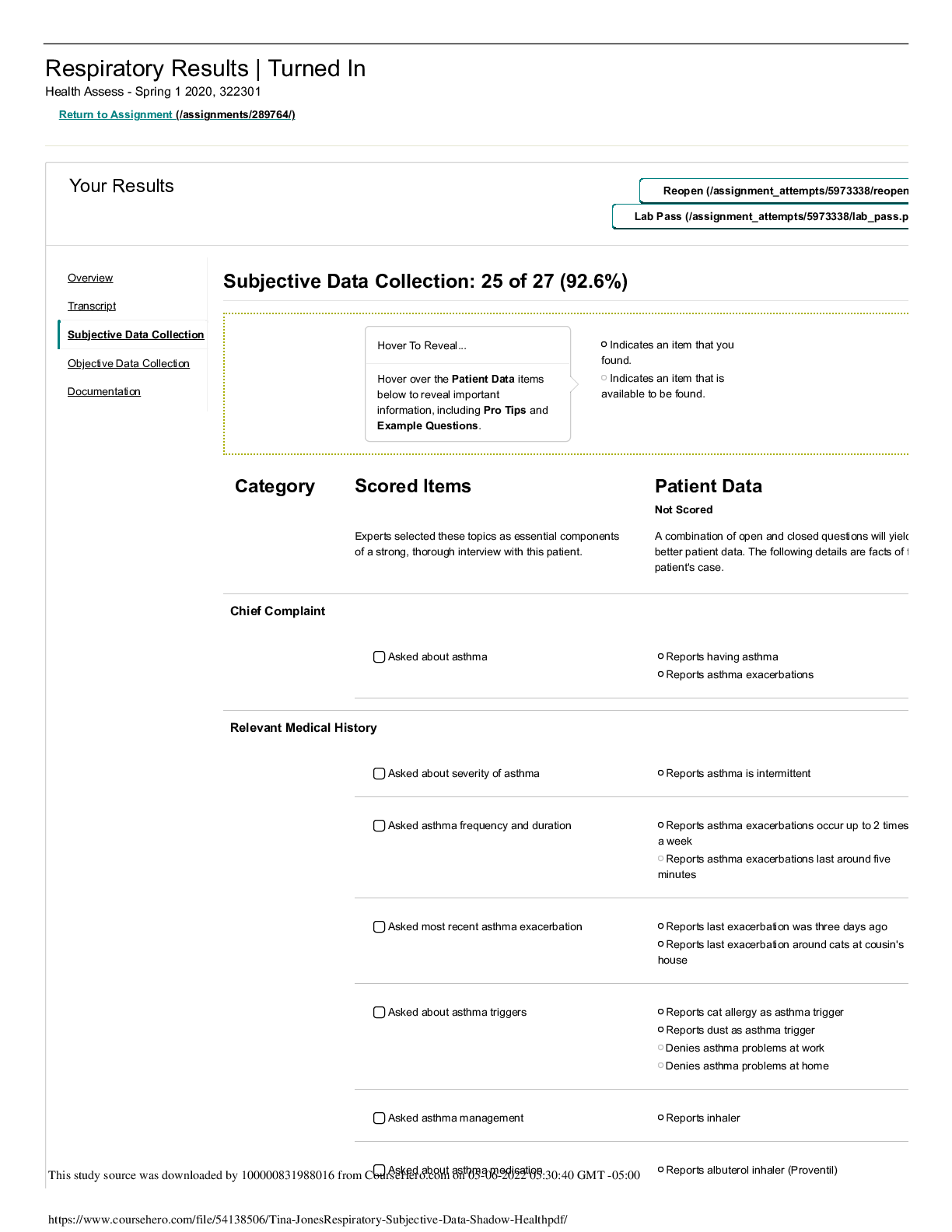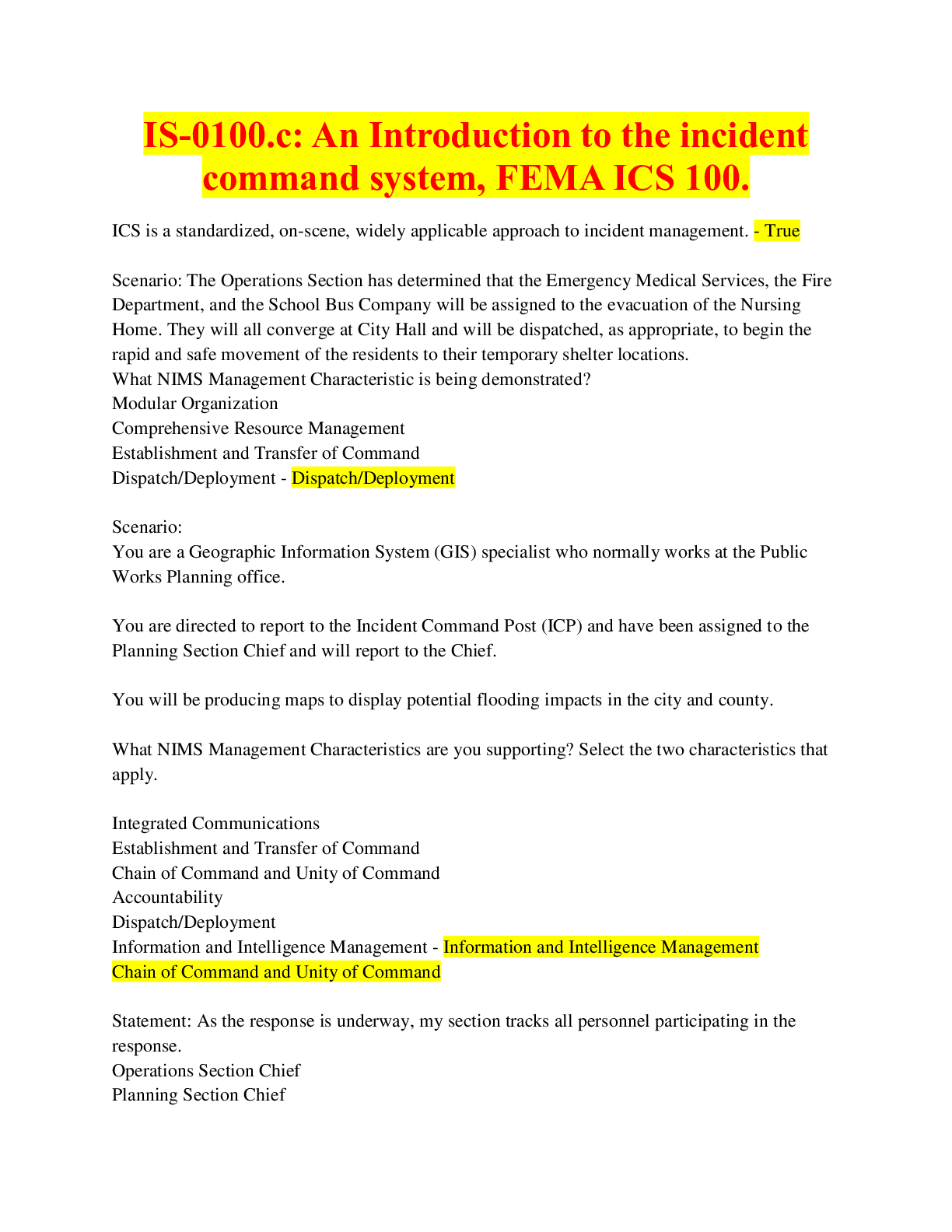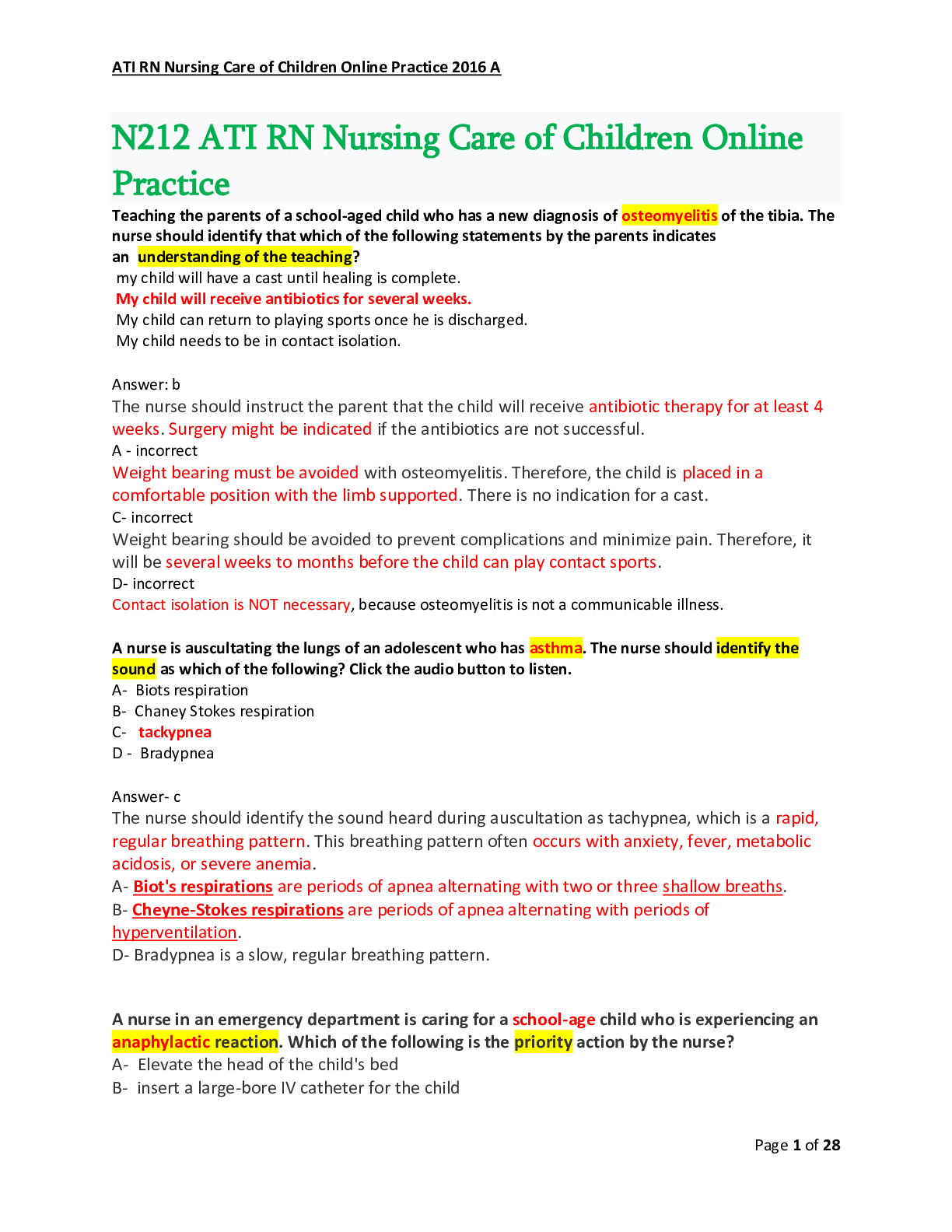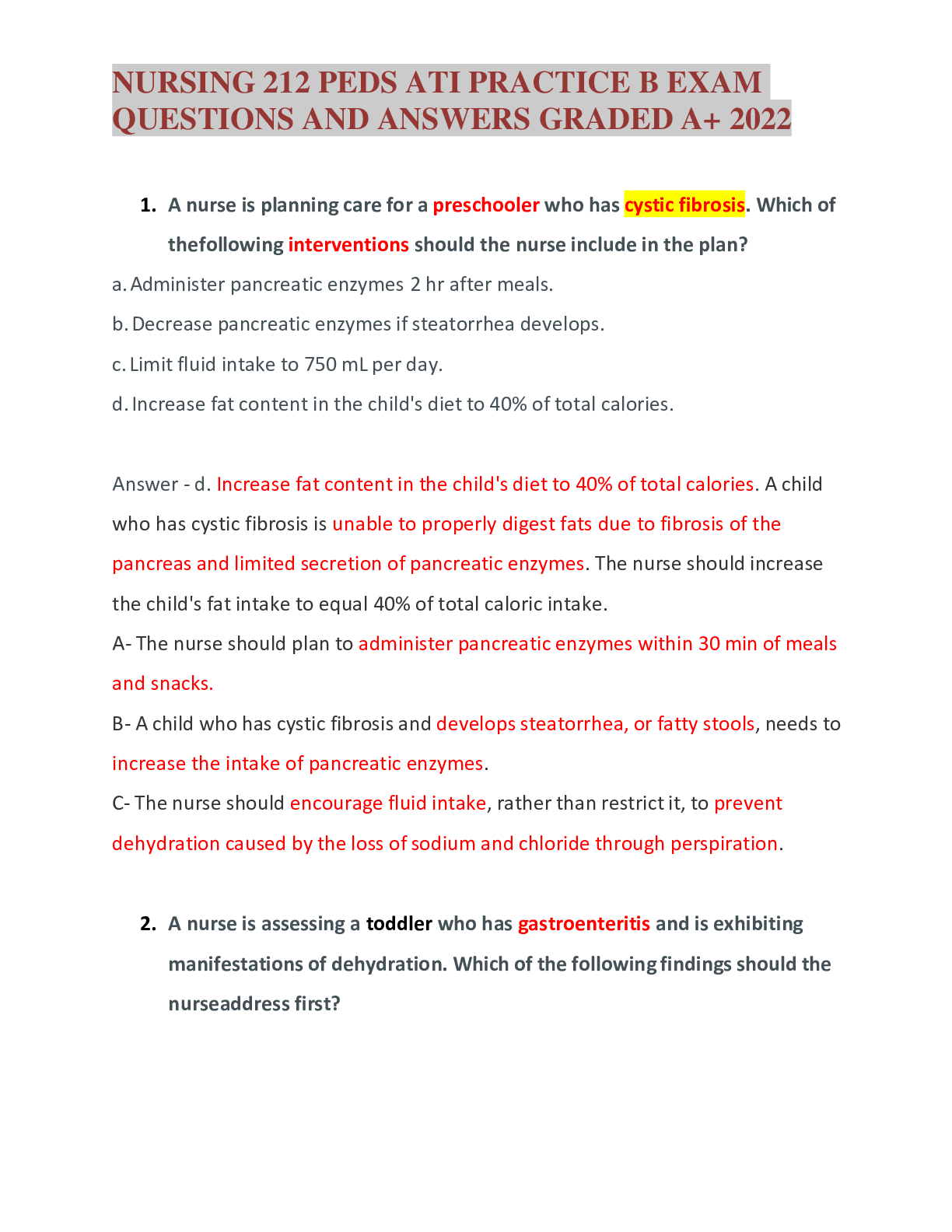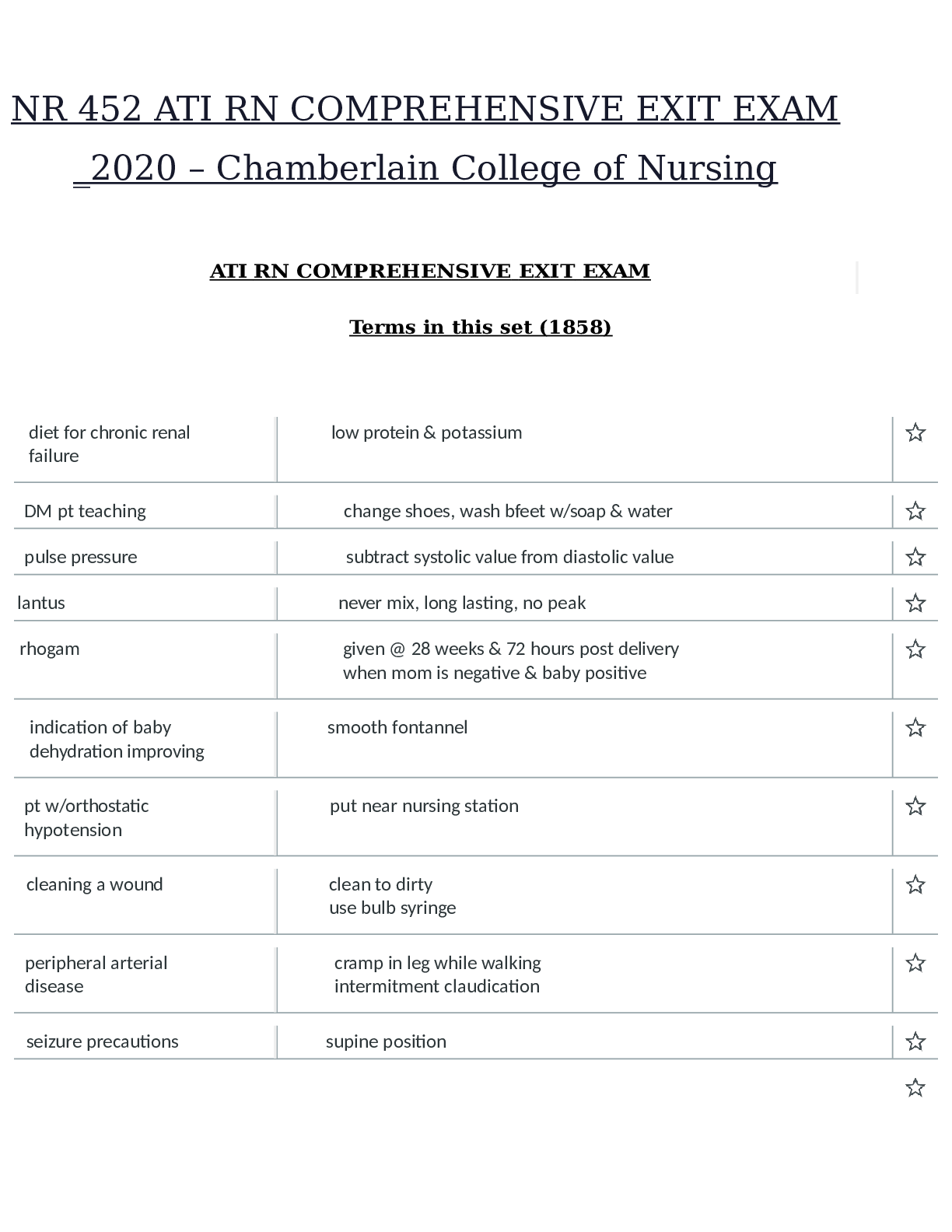*NURSING > EXAM > Exam Retake 2 ATI RN Medical Surgical Med Surg A with rationales, Answered Correctly (All)
Exam Retake 2 ATI RN Medical Surgical Med Surg A with rationales, Answered Correctly
Document Content and Description Below
Exam Retake 2 ATI RN Medical Surgical Med Surg A with rationales, Answered Correctly-A nurse is caring for a client who has a closed head injury and has an intraventricular catheter placed. Which of t... he following findings indicates that the client is experiencing increased intracranial pressure (ICP)? (Select all that apply.) A. Flat jugular veins B. A Glasgow Coma Scale score of 15 C. Sleepiness exhibited by the client D. Widening pulse pressure E. Decerebrate posturing - C, D, E Flat jugular veins is incorrect. With increased ICP, the jugular veins are typically distended. A Glasgow Coma Scale score of 15 is incorrect. A Glasgow Coma Scale score of 15 indicates neurological functioning within the expected reference range for eye opening, motor, and verbal response. Sleepiness exhibited by the client is correct. Sleepiness or difficulty arousing the client from sleep is an indication of increased ICP. Widening pulse pressure is correct. A widening pulse pressure (increase in systolic with concurrent decrease in diastolic blood pressure) is an indication of increased ICP. Decerebrate posturing is correct. Both decerebrate and decorticate posturing indicate increased ICP. A nurse is preparing a client who has supraventricular tachycardia for elective cardioversion. Which of the following prescribed medications should the nurse instruct the client to withhold for 48 hr prior to cardioversion? A. Enoxaparin B. Metformin C. Diazepam D. Digoxin - D. Digoxin Cardiac glycosides, such as digoxin, are withheld prior to cardioversion. These medications can increase ventricular irritability and put the client at risk for ventricular fibrillation after the synchronized countershock of cardioversion. AA A nurse is assessing a client who has acute cholecystitis. Which of the following findings is the nurse's priority? A. Anorexia B. Abdominal pain radiating to the right shoulder C. Tachycardia D. Rebound abdominal tenderness - C. Tachycardia When using the urgent vs. nonurgent approach to client care, the nurse should determine that the priority finding is tachycardia. Tachycardia is a manifestation of biliary colic, which can lead to shock. The nurse should position the head of the client's bed flat and report this finding immediately to the provider. A nurse is preparing to admit a client who has dysphagia. The nurse should plan to place which of the following items at the client's bedside? A. Suction machine B. Wire cutters C. Padded clamp D. Communication board - A. Suction machine The nurse should ensure that a suction machine is at the bedside of a client who has dysphagia to clear the client's airway as needed and reduce the risk for aspiration. A nurse is caring for a client who is having a seizure. Which of the following interventions is the nurse's priority? A. Loosen the clothing around the client's neck B. Check the client's pupillary response C. Turn the client to the side D. Move furniture away from the client - C. Turn the client to the side The greatest risk to this client is hypoxia from an impaired airway. Therefore, the priority intervention the nurse should take is to place the client in a side-lying position to prevent aspiration. A nurse is providing teaching to a client who has hypothyroidism and is receiving levothyroxine. The nurse should instruct the client that which of the following supplements can interfere with the effectiveness of the medication? A. Ginkgo biloba B. Glucosamine C. Calcium D. Vitamin C - C. Calcium Calcium limits the development of osteoporosis in clients who are postmenopausal and works as an antacid. Calcium supplements can interfere with the metabolism of a number of medications, including levothyroxine. The nurse should instruct the client to avoid taking calcium within 4 hr of levothyroxine administration. A nurse is planning to irrigate and dress a clean, granulating would for a client who has a pressure injury. Which of the following actions should the nurse take? A. Apply a wet-to-dry gauze dressing B. Irrigate with hydrogen peroxide solution C. Use a 30-mL syringe D. Attach a 24-gauge angiocatheter to the syringe - C. Use a 30-mL syringe The nurse should use a 30-mL to 60-mL syringe with an 18- or 19-gauge catheter to deliver the ideal pressure of 8 pounds per square inch (psi) when irrigating a wound. To maintain healthy granulation tissue, the wound irrigation should be delivered at between 4 and 15 psi. A nurse is providing teaching to a female client who has a history of urinary tract infections (UTIs). Which of the following information should the nurse include in the teaching? A. Avoid foods that are high in ascorbic acid B. Add oatmeal to the water when taking a tub bath C. Urinate every 6 hr D. Take daily cranberry supplements - D. Take daily cranberry supplements The client should take cranberry supplements or drink low-fructose cranberry juice because it contains compounds that adhere to the urinary tract wall, decreasing the risk for developing a UTI. A nurse is providing teaching to a client who has esophageal cancer and is to undergo radiation therapy. Which of the following statements should the nurse identify as an indication that the client understands the teaching? A. "I will was the ink markings off the radiation area after each treatment." B. "I will use my hands rather than a washcloth to clean the radiation area." C. "I will be able to be out of the sun 1 month after my radiation treatments are over." D. "I will use a heating pad on my neck if it becomes sore during the radiation therapy." - B. "I will use my hands rather than a washcloth to clean the radiation area." The client should gently wash the radiation area with their hands using warm water and mild soap to protect the skin from further irritation. A nurse is caring for a client 1 hr following a cardiac catheterization. The nurse notes the formation of a hematoma at the insertion site and a decreased pulse rate in the affected extremity. Which of the following interventions is the nurse's priority? A. Initiate oxygen at 2 L/min via nasal cannula B. Apply firm pressure to the insertion site C. Take the client's vital signs D. Obtain a stat order for an aPTT - B. Apply firm pressure to the insertion site The greatest risk to the client is bleeding. Therefore, the priority intervention is for the nurse to apply firm pressure to the hematoma to stop the bleeding. A nurse is caring for a client who has emphysema and is receiving mechanical ventilation. The client appears anxious and restless, and the high-pressure alarm is sounding Which of the following actions should the nurse take first? A. Obtain ABGs B. Administer propofol to the client C. Instruct the client to allow the machine to breathe for them D. Disconnect the machine and manually ventilate the client - C. Instruct the client to allow the machine to breathe for them When providing client care, the nurse should first use the least restrictive intervention. Therefore, the first action the nurse should take is to provide verbal instructions and emotional support to help the client relax and allow the ventilator to work. Clients can exhibit anxiety and restlessness when trying to "fight the ventilator." A nurse is reviewing the laboratory results of a client who has cirrhosis. Which of the following laboratory values should the nurse expect? A. Decreased prothrombin time B. Elevated bilirubin level C. Decreased ammonia level D. Elevated albumin level - B. Elevated bilirubin level Bilirubin levels reflect the liver's ability to conjugate and excrete bilirubin, a byproduct of the hemolysis of red blood cells. Bilirubin levels rise with liver disease and clinically reflect the client's degree of jaundice. A nurse is teaching a client who has venous insufficiency about self-care. Which of the following statements should the nurse identify as an indication that the client understands the teaching? A. "I should avoid walking as much as possible." B. "I should sit down and read for several hours a day." C. "I will wear clean graduated compression stockings every day." D. "I will keep my legs level with my body when I sleep at night." - C. "I will wear clean graduated compression stockings every day." [Show More]
Last updated: 6 months ago
Preview 1 out of 23 pages
Instant download

Buy this document to get the full access instantly
Instant Download Access after purchase
Add to cartInstant download
Also available in bundle (1)

BUNDLE: 2023/2024 ATI MED SURG EXAMS PACKAGE, All Graded, 100% CORRECT
BUNDLE: 2023/2024 ATI MED SURG EXAMS PACKAGE, All Graded, 100% CORRECT
By PROF 6 months ago
$55.5
12
Reviews( 0 )
Document information
Connected school, study & course
About the document
Uploaded On
Dec 08, 2023
Number of pages
23
Written in
Additional information
This document has been written for:
Uploaded
Dec 08, 2023
Downloads
0
Views
29






